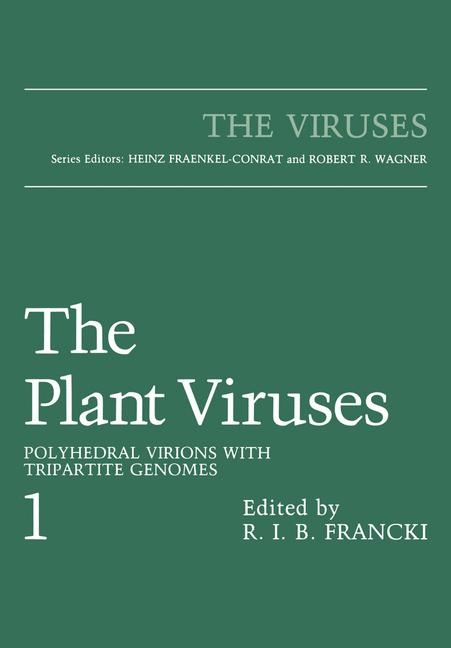
The Plant Viruses
Kluwer Academic/Plenum Publishers (Verlag)
978-0-306-41958-4 (ISBN)
- Titel ist leider vergriffen;
keine Neuauflage - Artikel merken
1 The Viruses and Their Taxonomy.- I. Introduction.- II. Members of the Tricornaviridae.- A. Bromovirus Group.- B. Cucumovirus Group.- C. Ilarvirus Group.- D. Alfalfa Mosaic Virus Group.- III. Taxonomic Considerations.- A. Features Common to All Tricornaviridae.- B. Comparison of the Bromoviruses with the Cucumoviruses.- C. Comparison of AMV with the Ilarviruses.- D. Significance of Genome Primary Structure to Taxonomy.- IV. Conclusions.- References.- 2 Virus Particle Stability and Structure.- I. Introduction.- II. Atomic Resolution Structures of Spherical Viruses.- A. Icosahedral Symmetry of Protein Capsids.- B. Structures of TBSV, SBMV, and STNV.- III. Virus Descriptions and Structure.- A. Alfalfa Mosaic Virus.- B. Ilarviruses.- C. Bromoviruses.- D. Cucumoviruses.- References.- 3 Viral Genome Structure.- I. Introduction.- II. General Structure of Tripartite Genomes.- III. RNA Sequence and Gene Content.- A. Information Derived from RNAs That Have Been Completely Sequenced.- B. Proportion of Each RNA Containing Protein-Coding Regions.- C. Are There Overlapping Reading Frames on Viral RNAs? Are There Subgenomic RNAs Other than RNA 4?.- IV. Sequence and Structure of Viral RNAs.- A. 5’-Terminal Sequences.- B. Sequences Upstream from Initiating AUG.- C. 3’-Terminal Sequences and Structures.- D. Intercistronic Region of RNA 3.- E. Characterization of Viral RNAs by Hybridization Analysis.- V. Satellite RNAs of the Cucumoviruses.- References.- 4 Virus Multiplication.- I. Introduction.- II. Experimental Systems.- A. Whole Plants.- B. Protoplasts.- C. In Vitro Systems.- III. Virus Entry and Uncoating.- IV. Virus Replication.- A. Initial Translation.- B. Proteins Involved in Replication.- C. RNA Replication.- D. Further Translation Products.- E. Inhibitors.- F. Time Courses of Replication.- G. Joint Infections of Viruses and Virus Strains.- V. Assembly in Relation to Virus Replication.- VI. Cellular Location of RNA Replication.- VII. Cell-to-Cell Spread.- VIII. Conclusions.- References.- 5 Virus Genetics.- I. Introduction.- II. Analysis of Pseudorecombinants Constructed from Genome Parts of Naturally Occurring Virus Strains.- III. Analysis of Incomplete Infections.- IV. Analysis of Mutants.- A. Type of Mutants.- B. Determination of ts Character.- C. Spontaneous Mutations.- D. Stability of Mutants.- E. Induction of Mutations.- F. Selection of Mutants.- G. Reversion of Mutations.- H. Assignment of Mutations to RNA Components.- I. Complementation and Interference between Mutants with ts Defects and the Same RNA.- J. Viral Functions Affected by Mutations.- V. Summary and Prospects.- VI. Glossary of Mutants Cited in This Chapter.- References.- 6 Virus-Host Relationships: Symptomatological and Ultrastructural Aspects.- I. Introduction.- II. Effects of Virus Infection on Host Morphology and Cell Structure.- III. Symptomatology.- IV. Cytopathology.- A. Cucumovirus Group.- B. Bromovirus Group.- C. Ilarvirus Group.- D. Alfalfa Mosaic Virus.- V. Concluding Remarks.- References.- 7 Serology and Immunochemistry.- I. Introduction.- II. Immunological Techniques.- A. Problems with Immunization.- B. Serological Techniques.- III. Serological Relationships.- A. Relationships between Viruses.- B. Relationships between Virus Strains.- IV. Immunochemical Studies.- A. Current Status.- B. The Viruses as Model Tools for Immunochemical Research.- V. Taxonomic Implications.- VI. Concluding Remarks.- References.- 8 Virus Transmission.- I. Introduction.- II. Modes of Transmission.- A. Bromoviruses.- B. Alfalfa Mosaic Virus.- C. Cucumoviruses.- D. Ilarviruses.- III. Concluding Remarks.- References.- 9 Virus Epidemiology and Control.- I. Introduction.- II. Pollen-Borne Viruses.- A. Behavior of Insects and Patterns of Virus Spread.- B. The Epidemiology of Specific Diseases.- C. Perennial Hosts and Virus Survival.- D. Spread of Viruses within the Tissues of Woody Hosts.- III. Aphid-Borne Viruses.- A. Aphid Behavior.- B. Epidemiology of Aphid-Borne Viruses.- IV. Epidemiology of Bromoviruses.- V. Control.- A. Production of Virus-Free Plants.- B. Reduction of Virus Spread.- VI. Discussion.- References.
| Erscheint lt. Verlag | 30.6.1985 |
|---|---|
| Reihe/Serie | The Viruses |
| Zusatzinfo | XV, 309 p. |
| Verlagsort | New York |
| Sprache | englisch |
| Gewicht | 728 g |
| Themenwelt | Naturwissenschaften ► Biologie ► Botanik |
| ISBN-10 | 0-306-41958-0 / 0306419580 |
| ISBN-13 | 978-0-306-41958-4 / 9780306419584 |
| Zustand | Neuware |
| Haben Sie eine Frage zum Produkt? |
aus dem Bereich


